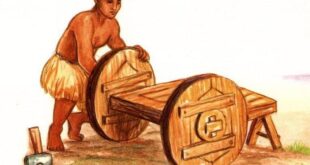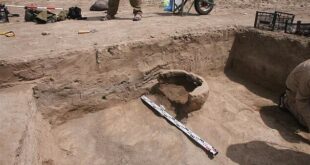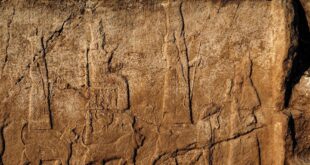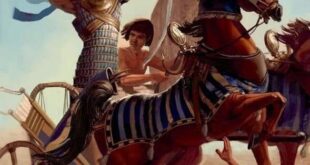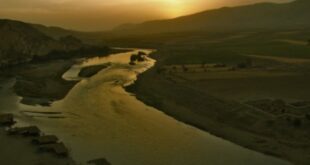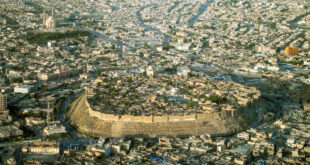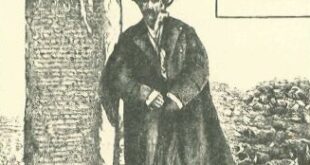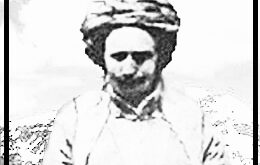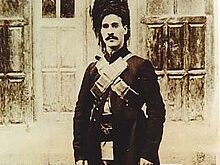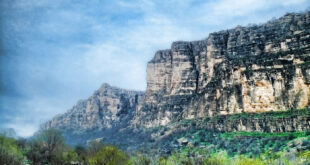Last updated: November 20, 2019 by Saugat Adhikari The cradle of civilization, Mesopotamia, was the birthplace of many valuable inventions and discoveries. It was here that agriculture began. Irrigation and farming were commonplace in this area because of the fertile land between the Euphrates and Tigris rivers. The invention of agriculture made it …
Read More »Russian archaeologists discover 4,000-year-old city in southern Iraq
Russian researchers have discovered the ruins of a 4,000-year-old settlement that rose from the ashes of the Babylonian empire in Iraq. Russian archaeologists in southern Iraq have uncovered evidence of a settlement from 4,000 years ago, including a temple wall and an ancient port for ships to anchor The ‘lost city’ …
Read More »Archaeologists in Iraq find 2,700-year-old wine press from rule of Assyrian kings
Archaeologists in Iraq revealed Sunday their discovery of a large-scale wine factory from the rule of the Assyrian kings 2,700 years ago, along with stunning monumental rock-carved royal reliefs. The carvings, from 2,700 years ago, show gods, kings and sacred animals. The stone bas-reliefs, showing kings praying to the gods, were cut …
Read More »Hittite
Hittite, member of an ancient Indo-European people who appeared in Anatoliaat the beginning of the 2nd millennium BCE; by 1340 BCE they had become one of the dominant powers of the Middle East. Probably originating from the area beyond the Black Sea, the Hittites first occupied central Anatolia, making their …
Read More »Complete Guide on Ancient Mesopotamia
Ancient Mesopotamia in a Nutshell Civilization Name: Mesopotamia Period: 3500 BC -500 BC Originated Location: northeast by the Zagros Mountains, southeast by the Arabian Plateau Current Location: Iraq, Iran, Syria, and Turkey Meaning: land between rivers [Ancient Greek] Major Highlights: First civilization in the world Mesopotamian was the world’s earliest civilization between the land of the …
Read More »Erbil
Erbil, also called Hawler (Kurdish: ھەولێر ,Hewlêr[3] Arabic: أربيل, romanized: Arbīl,[4] Syriac: ܐܲܪܒܹܝܠ,[5] or Arbel)[6] and known in ancient history as Arbela, is the capital and most populated city in the Kurdistan Region of Iraq.[7] There is no current census of the city and official population statistics are not available, its population is estimated to be around 1,200,000.[2] Erbil ھەولێر Clockwise, from top: Downtown, Mudhafaria …
Read More »Kelashin Stele
The Kelashin Stele (also Kelishin or Keli-Shin; from Kurdish Language: Blue Stone) found in Kelashin, Iraq, bears an important Urartian–Assyrian bilingual text dating to c. 800 BC, first described by Friedrich Eduard Schulz in 1827. Part of Schulz’s notes were lost when he was killed by Kurdish “bandits”, and later expeditions were either prevented by weather conditions or Kurdish brigands, so that a copy (latex squeeze) …
Read More »Abdullah Beg Benari
Abdullah Beg Benari was a Kurdish tribal leader, who lived from 1880 to 1939. He was the son of Sheikh Jahangir, who was the son of Sultan Beg, and a descendant of Bradostian Kurdish princes who fought in the battle of Dimdim Castle against the Iranian invasion by the Shah Abbas in 1609. Abdullah lived in the …
Read More »Simko Shikak
Simko Shikak (born Ismail Agha Shikak 1887 – 1930, Kurdish: سمکۆی شکاک, romanized: Simko Şikak) was a Kurdish chieftain of the Shekak tribe. He was born into a prominent Kurdish feudal family based in Chihriq castle located near the Baranduz river in the Urmia region of northwestern Iran. By 1920, parts of Iranian Azerbaijan located west of Lake Urmia were under his control.[1] He led Kurdish farmers into battle and defeated the Iranian army on …
Read More »Bradost (mountain)
Bradost or Chia-y Bradost (Nawakhin), a mountain range over 5,000 feet above sea level and about 25 miles long, stretches northwest from the Rawanduz river opposite the town of Rawanduz in Erbil Governorate, Kurdistan Region, Iraq, to Rubari kuchuk, a tributary of the Great Zab.[1] Bradost mountain range The Shanidar Cave,a Neandertalian archaeological site, lies about 15 …
Read More » History of Kurdistan
History of Kurdistan
